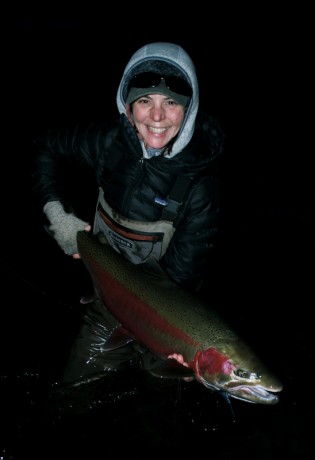
Many spey casting faults can be traced all the way back to the very beginning of the cast, that’s right, on the lift. It’s the lift that sets the stage for a well executed cast, yet it receives little attention from those looking to fine-tune their casting.
However, we won’t waste time trying to convince you about the importance of a good lift. We’ll let four-time female world spey casting champion and Alaska West alum, Whitney Gould, explain the finer points of the lift instead!
Take it away Whit!
The Lift – Don’t be a Drag
The initial fly line lift from the water’s surface should be a vertical lift and not a drag. A drag is not only tedious but also forceful. Crashed, skewed, or misplaced anchors and excessive line stick are all symptoms of an improper line lift and set. A faulty lift will influence the outcome of the entire cast.
Whether performing a cast developed on the water’s surface (such as the double spey or circle C), a cast developed in the air (such as a single spey or snake roll), or whether using a short or long shooting head, the cast will benefit from a clean line lift, one that starts with intent.
What is a Lift?
The lift is simply the vertical movement of the rod that picks up the fly, leader and line to move to an intended location.
A good lift sets the ground work for an efficient sweep of the fly line, allowing the fly to be set at the proper anchor point. A good anchor point, is located off of the side of your body to which the cast is being performed, a rod length’s away, and slightly in front of the caster.
Fundamentals of a Good Lift
A few key fundamentals to a good lift, are tempo, tension and timing. Start the vertical lift smooth and steady. Look to release the line from the waters surface in sequence, from the rod tip down to the leader. The line will follow the rod tip. Once you’ve started the lift, avoid stopping as this only introduces slack. Time the cast to match the amount of line you are fishing and your particular fishing situation.
Look to at your line for visual queues. I start with a straight line on the dangle, with the rod low and the tip just above the water’s surface. During the lift, I look at the connection between the leader and fly line (nail knot). When this connection starts to move in my direction, and the fly line has released from the water’s surface from the rod tip down, I know I can begin my sweep.
Remember not to pause at the top of the lift, as a pause will only introduce slack. Also, as mentioned earlier don’t avoid the lift by dragging the line to the set. On the other hand, it is equally important to avoid an excessive lift as well. I suggest going out and playing with different lifts.
Leave a Reply